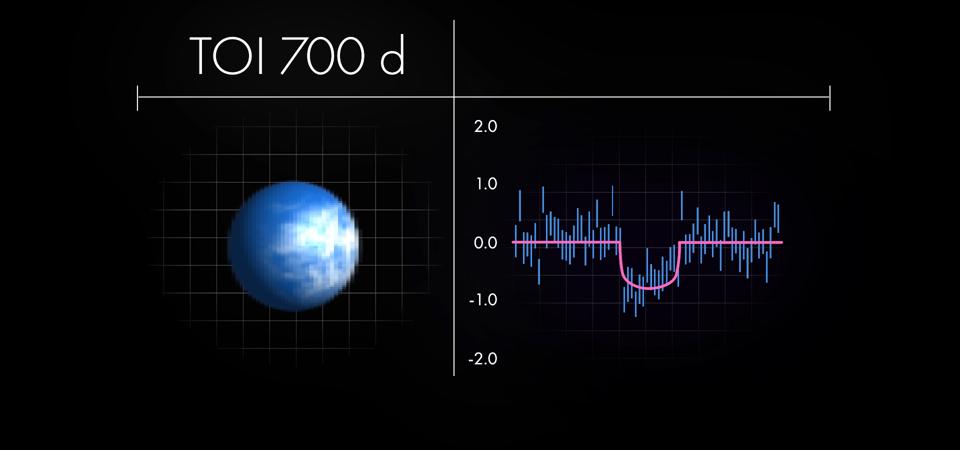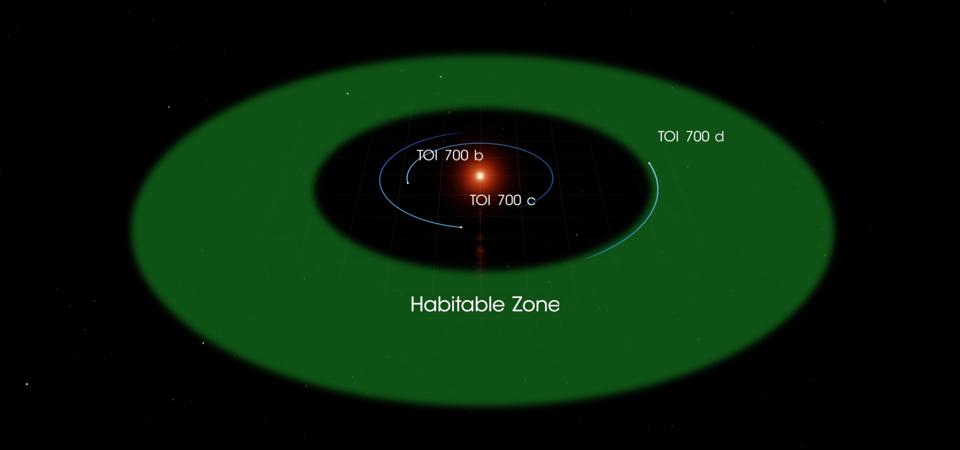
This is an artist’s impression of TOI 700 d, the first Earth-size habitable-zone planet discovered ... [+]
Astronomers using NASA's Transiting Exoplanet Survey Satellite (TESS) has discovered its first Earth-size planet in its star's habitable zone. That’s crucial because it may mean the planet, called TOI 700 d, has liquid water on its surface.
It also appears to have one side of the planet in eternal sunshine and the other in a never-ending night.
What and where is planet TOI 700 d?
It’s orbiting a star called TOI 700, a cool “M dwarf” star about 100 light-years away in the southern constellation of Dorado, the dolphinfish. About 40% of the Sun’s mass and size, and about half its surface temperature, TOI 700 is bright, nearby, and shows no sign of harmful “stellar flares.” That means that any planets in orbit don’t get frequent blasts of deadly radiation that would almost certainly make life impossible.
However, the TOI 700 star system is unlike the solar system in that all three planets detected so far are thought to be tidally locked to their star. That means they show only one face to the star—as the moon does to Earth—but it therefore means that only one side ever gets daylight.
TESS’s first Earth-size planet in its star's habitable zone is nevertheless destined to be a very weird world indeed.
What is an M dwarf star?
It’s a red dwarf, the smallest sort of star and the most common type of star in the Milky Way galaxy. However, they’re too small to see with the naked eye. Cool and stable, most of the potentially habitable exoplanets discovered so far have been around red dwarfs. That’s partly because they’re so numerous and therefore the easiest type of stars to study, but as mentioned already, it’s also because they don’t flare. “In 11 months of data we saw no flares from the star, which improves the chances TOI 700 d is habitable and makes it easier to model its atmospheric and surface conditions,” says Emily Gilbert, a graduate student at the University of Chicago.
Gilbert and other researchers presented the findings at the 235th meeting of the American Astronomical Society in Honolulu, and three papers (one led by Gilbert) have been submitted to scientific journals.

The outermost planet, TOI 700 d, is the only one of the known worlds in this system in the habitable ... [+]
How was TOI 700 d discovered?
Scientists were able to study TOI 700 a lot during the TESS mission’s first year, detecting a total of three planets crossing TOI 700 from the satellite’s point of view (called a transit). A team of scientists led by Joseph Rodriguez, an astronomer at the Center for Astrophysics, Harvard & Smithsonian in Cambridge, Massachusetts confirmed the find using NASA’s Spitzer Space Telescope. “Given the impact of this discovery—that it is TESS’s first habitable-zone Earth-size planet—we really wanted our understanding of this system to be as concrete as possible,” says Rodriguez. “Spitzer saw TOI 700 d transit exactly when we expected it to. It’s a great addition to the legacy of a mission that helped confirm two of the TRAPPIST-1 planets and identify five more.”

The only planet currently known to be in the habitable zone is TOI 700 d.
What do we know about the three planets of the TOI 700 d star system?
Though further measurements from ground-based observatories are needed to confirm, the scientists estimate that the inner and outer planets are rocky, and the middle planet is a gas planet. Future missions—such as the James Webb Space Telescope (JWST)—may also be able to identify whether the planets have atmospheres, and also determine their compositions.
However, here’s what we know so far:
- TOI 700 b: the innermost planet is almost exactly Earth-size, is probably rocky, and completes an orbit every 10 days. However, it’s not in the star’s habitable zone; it’s way too hot.
- TOI 700 c: the middle planet is 2.6 times larger than Earth, orbits every 16 days and is likely a gas-dominated world. It’s also not in the star’s habitable zone.
- TOI 700 d: the outermost planet in the system, it’s the only detected planet in the habitable zone. It’s probably rocky, it’s just 20% larger than Earth, it orbits every 37 days, and it receives from its star 86% of the energy that the Sun provides to Earth.
Is TOI 770 d habitable? Possibly, though any life that exists on TOI 700 d would need to adapt to some pretty strange prevailing atmospheric conditions.

Researchers created 20 different 3D climate models of TOI 700 d to determine if any version resulted ... [+]
What might TOI 700 d be like?
What would life be like on a planet that has two halves—one constantly bathed in daylight, and one that is always on the night-side. It’s too early to say whether there are moons around TOI 700 d that might bring some kind of reflected light to the night-side.
Since TOI 700 d is tidally locked to its star and has a never-ending day and night, there is likely a stark temperature difference between the two sides. So the planet’s cloud formations and wind patterns may be strikingly different from Earth’s.
“No matter what we find out about the planet, it’s going to look completely different from what we have here on Earth,” says Gabrielle Engelmann-Suissa, a Universities Space Research Association visiting research assistant at NASA’s Goddard Space Flight Center in Greenbelt, Maryland, which modeled 20 potential environments of TOI 700 d. Using a variety of surface types and atmospheric compositions that could be regarded as potentially habitable, simulations included:
- An ocean-covered planet: a dense, carbon-dioxide-dominated atmosphere much like a young Mars, with a deep layer of clouds on the star-facing side.
- A cloudless, all-land version of modern Earth: winds flow away from the night side of the planet and converge on the point directly facing the star.

This simulation of TOI 700 d depicts an ocean-covered world with a dense, carbon-dioxide-dominated ... [+]
How many exoplanets are potentially habitable?
TOI 700 d is one of only a handful Earth-size planets discovered in a star’s habitable zone so far. Others include several planets in the TRAPPIST-1 system and other worlds discovered by NASA’s incredibly successful Kepler Space Telescope. However, all astronomers can say for now is that an exoplanet resides it that star’s habitable zone. The size and extent of that zone is dependent on size and nature of the star, but what makes it a special place is that it’s where liquid water can exist on a planet’s surface, i.e. it’s not too close and hot to its star for water to boil away, and it’s not too far away and cold for the water to freeze. It’s therefore often called the “Goldilocks zone.”
The closest potentially habitable planet to the solar system is Proxima Centauri b in the nearest star system, which is just 4.2 light years away. Others within 20 light years include Teegarden’s Star in Aries, Luyten’s Star in Canis Minor, Wolf 1061c in Ophiuchus, and Kapteyn's Star in Pictor.

NASA's Transiting Exoplanet Survey Satellite (TESS), shown here in a conceptual illustration, is ... [+]
Discovering TOI 700 d is a landmark moment for TESS.
“TESS was designed and launched specifically to find Earth-sized planets orbiting nearby stars,” said Paul Hertz, astrophysics division director at NASA Headquarters in Washington, who thinks that planets around nearby stars like TOI 700 are easiest to follow-up with larger telescopes in space and on Earth.
This discovery is also one of the last for NASA’s Spitzer Space Telescope, which launched back in 2003. “Confirming the planet’s size and habitable zone status is another win for Spitzer as it approaches the end of science operations this January,” said Hertz.
Wishing you wide eyes and clear skies.
https://www.forbes.com/sites/jamiecartereurope/2020/01/07/welcome-to-toi-700-d-the-first-earth-size-habitable-zone-world-found-by-nasas-planet-hunter/
2020-01-07 11:18:58Z
52780542076776
Bagikan Berita Ini















0 Response to "Welcome To ‘TOI 700 d,’ The First Earth-Size Habitable-Zone World Found By NASA’s Planet Hunter - Forbes"
Post a Comment